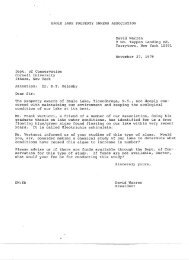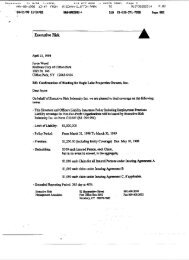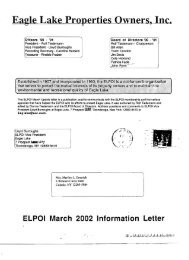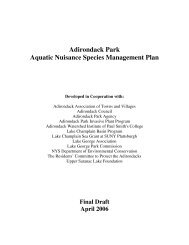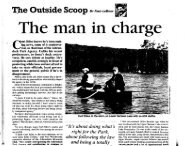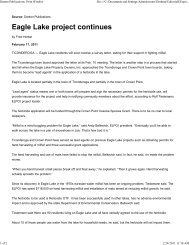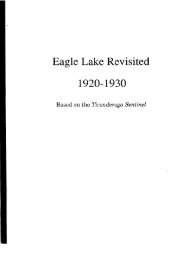SEIS - Eagle Lake Property Owner's Inc.
SEIS - Eagle Lake Property Owner's Inc.
SEIS - Eagle Lake Property Owner's Inc.
Create successful ePaper yourself
Turn your PDF publications into a flip-book with our unique Google optimized e-Paper software.
Alternatively, multiple low dose treatments with Sonar® AS have been successfully applied inareas where dilution could not be adequately controlled. Sequential treatment with Sonar® AStwo to four times over a time period of up to a month, as needed to maintain a concentrationnear 0.01 mg/l (10 ppb), can mimic the action of slow release pellets. Sequential treatments maybe in conflict with time restrictions for <strong>Eagle</strong> <strong>Lake</strong>, however, as treatment after the MemorialDay weekend is not preferred. There is no clear scientific basis for this date preference, merelyan understandable desire to minimize risk. It may be necessary to treat through June forsequential treatments to be effective. Treatment should not begin before milfoil begins activegrovvth, which can be as late as mid-May in <strong>Eagle</strong> <strong>Lake</strong>. It is expected, however, that a singleapplication may be sufficient for <strong>Eagle</strong> <strong>Lake</strong>.An immunoassay is available (Bums, pers. comm.) which allows field measurement of thefluridone concentration. This allows tracking of the fluridone concentration with additivetreatment where and when necessary over a multi-week period. It is also possible to mimic themovement of fluridone with rhodamine dye, with additive treatments when the dye level declinesbelow a set threshold indicative of the lowest desired concentration of fluridone.Based on what is known of fluridone at this time, there appears to be negligible risk to humanhealth or the aquatic environment from its appropriate use in <strong>Eagle</strong> <strong>Lake</strong>. There are a number oftechnical issues to be resolved, including the timing of treatment and how to handle possibledilution factors, but this herbicide appears to offer the features necessary to make it a valuabletool in the control of Eurasian watermilfoil in <strong>Eagle</strong> <strong>Lake</strong>.Physical means are available to control milfoil as it is discovered in very small quantities, and toeliminate or reduce its presence in small patches of moderate to high density. However, there isnot currently a tool in the management arsenal for <strong>Eagle</strong> <strong>Lake</strong> that would allow cost effectivemajor reduction of milfoil over areas larger than about an acre at moderate to high densities.Fluridone offers this potential, and its use appears consistent with the goal of restoration of ahealthy native plant assemblage in milfoil-infested areas of <strong>Eagle</strong> <strong>Lake</strong>.The cost of fluridone treatments will vary with area treated, water depth, dose and the applicationmode. Experience elsewhere for areas > ~ 0 acres dictates a cost range of $400-750 for singletreatments, exclusive of any special controls mandated by environmental constraints. Singletreatments of smaller areas are expected to cost between $600 and $1500/acre, with multipletreatments resulting in costs of up to $2000/acre. Costs for educating residents regarding thetreatments and for any preventive activities relating to water intakes are additional, andsignificant monitoring costs are anticipated.The volume of water in <strong>Eagle</strong> <strong>Lake</strong> is slightly less than 10 billion liters. At a targetconcentration of 10-20 ug~ (Ppb), 200 kg of active fluridone would be needed to achieve aninitial concentration of 20 ppb. A dose of 100 kg would achieve the 10 ppb concentration thatforms the lower limit of the target range.D<strong>SEIS</strong> for <strong>Eagle</strong> <strong>Lake</strong> 18 ENSR



